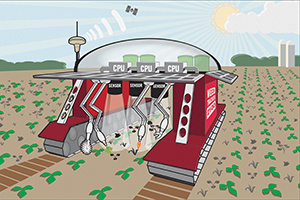Moving Integrated Weed Management into the Future
 |
|
An artist’s rendering could be the future of automated weed management. Source: Steve Young, Northeastern IPM Center |
On one level, integrated weed management (IWM) is all about diversification. Rather than relying solely on one or two herbicides, farmers employ a multiplicity of weed-fighting strategies including tillage and other mechanical tools, cultural practices, and methods for depleting the weed seed bank.
But on another level, IWM as currently practiced isn’t really integrated. Why not? Because it is still managing every weed the same regardless of location or season. In the future, automated systems could identify each and every plant in a farmer’s field and then go on to manage the undesirable ones. A robot could determine the weed species and its key features, like whether it is known to be resistant to mowing or spraying, if the seed is long-lived, or if parts of the plant can regenerate. The same robot, equipped with several different weed control tools, could apply the appropriate micro-treatment directly onto the target weed. An individual pigweed, for example, would be spritzed, snipped, or flash flamed in an instant.
While the idea is enticing and exciting to think about, one of the biggest hurdles now is to identify weeds in diverse field and weather conditions. In addition, the idea of a robot moving stealthily through a corn field still has to be accepted by the public, not to mention growers.
What will it take to overcome these challenges to move IWM to a level that makes it more applicable, widely adopted, and truly integrated? These will be addressed at the upcoming American Society of Agronomy, Crop Science Society of America, and Soil Science Society of America meetings in Minneapolis, Minnesota.
— by STEVE YOUNG
The Northeastern IPM Center promotes integrated pest management for reducing risks to human health and the environment. If republishing our news, please acknowledge the source (“From Northeast IPM Insights”) along with a link to our website.
